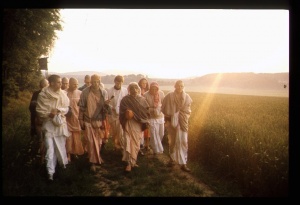CC Madhya 3.194: Difference between revisions
m (1 revision(s)) |
No edit summary |
||
| Line 1: | Line 1: | ||
{{ | [[Category:Sri Caitanya-caritamrta - Madhya-lila Chapter 03|C194]] | ||
<div style="float:left">'''[[Sri Caitanya-caritamrta|Śrī Caitanya-caritāmṛta]] - [[CC Madhya|Madhya-līlā]] - [[CC Madhya 3|Chapter 3: Lord Śrī Caitanya Mahāprabhu's Stay at the House of Advaita Acārya]]'''</div> | |||
<div style="float:right">[[File:Go-previous.png|link=CC Madhya 3.193|Madhya-līlā 3.193]] '''[[CC Madhya 3.193|Madhya-līlā 3.193]] - [[CC Madhya 3.195|Madhya-līlā 3.195]]''' [[File:Go-next.png|link=CC Madhya 3.195|Madhya-līlā 3.195]]</div> | |||
{{CompareVersions|CC|Madhya 3.194|CC 1975|CC 1996}} | |||
{{RandomImage}} | |||
==== TEXT 194 ==== | ==== TEXT 194 ==== | ||
<div | <div class="verse"> | ||
nīlācale yābe tumi, mora kon gati | :nīlācale yābe tumi, mora kon gati | ||
nīlācale yāite mora nāhika śakati | :nīlācale yāite mora nāhika śakati | ||
</div> | </div> | ||
| Line 12: | Line 16: | ||
==== SYNONYMS ==== | ==== SYNONYMS ==== | ||
<div | <div class="synonyms"> | ||
nīlācale yābe | ''nīlācale yābe tumi''—You will go to Jagannātha Purī; ''mora''—my; ''kon''—what; ''gati''—destination; ''nīlācale''—to Jagannātha Purī; ''yāite''—to go; ''mora''—my; ''nāhika''—there is not; ''śakati''—strength. | ||
</div> | </div> | ||
| Line 19: | Line 23: | ||
==== TRANSLATION ==== | ==== TRANSLATION ==== | ||
<div | <div class="translation"> | ||
Haridāsa Ṭhākura said, “You are going to Jagannātha Purī, and that is all right, but what will be my destination? I am not able to go to Jagannātha Purī. | Haridāsa Ṭhākura said, “You are going to Jagannātha Purī, and that is all right, but what will be my destination? I am not able to go to Jagannātha Purī. | ||
</div> | </div> | ||
| Line 26: | Line 30: | ||
==== PURPORT ==== | ==== PURPORT ==== | ||
<div | <div class="purport"> | ||
Although Śrīla Haridāsa Ṭhākura was born in a Muslim family, he was accepted as a properly initiated brāhmaṇa. As such, he had every right to enter the temple of Jagannātha Purī, but because there were some rules and regulations stipulating that only brāhmaṇas, kṣatriyas, vaiśyas and śūdras (members of the varṇāśrama-dharma system) could enter, Haridāsa Ṭhākura, out of his great humility, did not want to violate these existing rules. He therefore said that he did not have the strength to enter into the temple, and he pointed out that if Lord Śrī Caitanya Mahāprabhu lived within the temple, there would be no way for Haridāsa Ṭhākura to see Him. Later, when Haridāsa Ṭhākura went to Jagannātha Purī, he lived outside the temple, at a place called Siddhabakula. A monastery has now been erected there, known as Siddhabakula Maṭha. People who visit Jagannātha Purī often go to see Siddhabakula and the tomb of Haridāsa Ṭhākura, on the beach by the sea. | Although Śrīla Haridāsa Ṭhākura was born in a Muslim family, he was accepted as a properly initiated ''brāhmaṇa''. As such, he had every right to enter the temple of Jagannātha Purī, but because there were some rules and regulations stipulating that only ''brāhmaṇas'', ''kṣatriyas'', ''vaiśyas'' and ''śūdras'' (members of the ''varṇāśrama-dharma'' system) could enter, Haridāsa Ṭhākura, out of his great humility, did not want to violate these existing rules. He therefore said that he did not have the strength to enter into the temple, and he pointed out that if Lord Śrī Caitanya Mahāprabhu lived within the temple, there would be no way for Haridāsa Ṭhākura to see Him. Later, when Haridāsa Ṭhākura went to Jagannātha Purī, he lived outside the temple, at a place called Siddhabakula. A monastery has now been erected there, known as Siddhabakula Maṭha. People who visit Jagannātha Purī often go to see Siddhabakula and the tomb of Haridāsa Ṭhākura, on the beach by the sea. | ||
</div> | </div> | ||
__NOTOC__ | |||
<div style="float:right; clear:both;">[[File:Go-previous.png|link=CC Madhya 3.193|Madhya-līlā 3.193]] '''[[CC Madhya 3.193|Madhya-līlā 3.193]] - [[CC Madhya 3.195|Madhya-līlā 3.195]]''' [[File:Go-next.png|link=CC Madhya 3.195|Madhya-līlā 3.195]]</div> | |||
__NOTOC__ | |||
__NOEDITSECTION__ | |||
Revision as of 12:16, 25 July 2021

A.C. Bhaktivedanta Swami Prabhupada
TEXT 194
- nīlācale yābe tumi, mora kon gati
- nīlācale yāite mora nāhika śakati
SYNONYMS
nīlācale yābe tumi—You will go to Jagannātha Purī; mora—my; kon—what; gati—destination; nīlācale—to Jagannātha Purī; yāite—to go; mora—my; nāhika—there is not; śakati—strength.
TRANSLATION
Haridāsa Ṭhākura said, “You are going to Jagannātha Purī, and that is all right, but what will be my destination? I am not able to go to Jagannātha Purī.
PURPORT
Although Śrīla Haridāsa Ṭhākura was born in a Muslim family, he was accepted as a properly initiated brāhmaṇa. As such, he had every right to enter the temple of Jagannātha Purī, but because there were some rules and regulations stipulating that only brāhmaṇas, kṣatriyas, vaiśyas and śūdras (members of the varṇāśrama-dharma system) could enter, Haridāsa Ṭhākura, out of his great humility, did not want to violate these existing rules. He therefore said that he did not have the strength to enter into the temple, and he pointed out that if Lord Śrī Caitanya Mahāprabhu lived within the temple, there would be no way for Haridāsa Ṭhākura to see Him. Later, when Haridāsa Ṭhākura went to Jagannātha Purī, he lived outside the temple, at a place called Siddhabakula. A monastery has now been erected there, known as Siddhabakula Maṭha. People who visit Jagannātha Purī often go to see Siddhabakula and the tomb of Haridāsa Ṭhākura, on the beach by the sea.